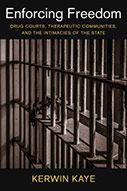Enforcing Freedom: Drug Courts, Therapeutic Communities, And The Intimacies Of The State

Author: Kerwin Kaye
Publisher: New York: Columbia University Press, 2020. 346p.
Reviewer: Sam Bieler | July 2020
The justice reform movement has called on many elements of the U.S. criminal justice system to account for its flaws. Now, in Enforcing Freedom: Drug Courts, Therapeutic Communities, and the Intimacies of the State, it is drug courts’ turn in the dock with Kerwin Kaye for the prosecution. Kaye argues that drug courts and therapeutic communities are ultimately tools of neoliberal social control that do more harm than good. Given drug courts’ popularity and the vast research base supporting them, a critical look at the concept is refreshing. However, as an indictment of drug courts, Enforcing Freedom stumbles, particularly in its efforts to envision a world without them.
Kaye has selected a challenging target. As one of the early successes of the evidence-based practice movement, drug courts, and the therapeutic communities they connect people to, have amassed a deep bench of defenders. These supporters, in turn, have created a large body of evidence suggesting that drug courts reduce recidivism and save the public money. Since drug courts seek to keep people out of prison through their programming, dismissing them out of hand as carceral tools is difficult. Kaye acknowledges all of this, and a key strength of Enforcing Freedom is his willingness to lay out the good and the bad of drug courts before making his case against them.
The author begins by challenging the research base supporting drug courts for focusing only on recidivism and cost reduction. Then, he questions the validity of the War on Drugs to undermine drug courts’ right to impose treatment. Finally, he questions the legitimacy of the classical liberal ideology that informs drug courts’ focus on job training and employment. Launching this three-front war is ambitious, but none of these attacks quite make it over the barricades.
Kaye opens with an assault on the research supporting drug courts. His issue is not with these studies’ methodology, but with their limited focus on drug courts’ ability to reduce recidivism and save costs. The argument deserves attention since, if nothing else, it shows how much progress the justice reform movement has made. In the heyday of the “tough on crime” movement, a focus on cost savings and public safety in programs like the Justice Reinvestment Initiative delivered some of the earliest successful reforms. However, given that the justice reform movement has gained ground, the book asks whether other values should animate the reform movement. If they should, then the next step is to ask how the research community can measure those values.
In theory, Enforcing Freedom is well placed to make this argument — Kaye has conducted the kind of detailed ethnographic study that can explore a wider range of issues than can be counted on a court docket or a program balance sheet. He spent thirteen months in the field at a New York City drug court and treatment facility, conducted four months of interviews with case managers and social workers, and then spent eight months visiting a therapeutic community, interviewing staff and residents and watching the treatment process. Moreover, when he describes scenes from his research, Kaye paints compelling pictures of the human costs of drug court treatment and the challenges residents of these therapeutic communities face going through the treatment program.
This detailed research and skilled writing do not, however, come together into a compelling critique of drug court research. The argument about analyzing drug courts with respect to different values is made early in the book, but is then left to the side and not seriously addressed later. If readers agree to stop evaluating drug courts on whether they prevent crime and save money, then the next question is how else to evaluate them. Enforcing Freedom does not provide the answer.
Similarly unanswered is the question about what drug courts and therapeutic communities look like in a world where drug use is no longer criminalized. Enforcing Freedom argues for ending the Drug War and making participation in therapeutic communities voluntary. It does not, however, grapple with what that world looks like. While people might no longer be steered into drug courts for drug crimes, consider a case where after using drugs, users begin harassing or intimidating neighbors on the street. Even without a War on Drugs, they could be arrested for a welter of other criminal charges. When that happens, Enforcing Freedom does not consider whether such users are better off with or without the option of mandatory drug courts and therapeutic communities.
An alternative reading of Kaye’s argument is that there should be no social control via policing. He is not the first to suggest this — Issa Kohler-Hausmann explored that question at length in Misdemeanorland, where she suggested that low-level criminal courts enforce social control through minor charges. Kaye’s argument positions drug courts as a smaller, more specialized outgrowth of this phenomenon. Given increasing skepticism about the possibility of using courts and criminal law for social control, asking how valid it is to impose any measure of social control through the courts is worthwhile.
Kaye never resolves this question beyond suggesting that such social control is illegitimate, which is a challenging position to take in a nation of 300 million people where drug and alcohol use will inevitably sometimes bring individuals and their broader communities into conflict. When that happens, the question arises as to how the rights of those in the community to live, work and raise families should be reconciled with the right of the individual to pursue happiness, whether through drugs, alcohol or otherwise, as each sees fit. Broken Windows policing answered this question by making the right of the community to having order paramount. Kaye seems to reject this, but leaves unanswered the question of whether, if order is not paramount, it has any standing as a law enforcement objective at all.
The author’s general assault on the neoliberal underpinnings of drug courts and therapeutic communities is similarly problematic in its open-endedness. Enforcing Freedom attacks drug courts and therapeutic communities for steering people towards low-wage jobs and condemns this treatment system for encouraging people to accept “tedium and rule-following” and “bureaucratic irrationalities.” To this, one might respond, “welcome to working.” Every job, even prestigious ones, features tedium and rule following. Moreover, criticizing drug courts for preferencing some kind of legal employment, even lower paying employment, over the underground economy or no job at all seems unfair.
Enforcing Freedom suggests that this habituation to tedium is a plot of the neoliberal order and offers broad socialist reforms as a cure to alleviate the need for therapeutic communities — as if a new economic order could relieve the bureaucracy baked into much of modern work. Additionally, to the degree that treatment programs continue to be supported by the public, Kaye does not make a case as to why such publicly funded programs should not encourage people to join the workforce and make their own contributions to the public welfare.
Finally, Kaye acknowledges that drug courts have been an immensely positive force for change in the lives of thousands of people. Readers might therefore expect evidence of similarly scaled harms if this system is to be replaced. While he notes that drug courts do not work for many people, as is common with any therapeutic intervention, he never compellingly tallies the harms in a way that suggests drug courts hurt more than they help.
Ultimately, Enforcing Freedom poses interesting questions but leaves readers with few answers. It criticizes the drug court research, but does not offer a replacement framework. It rejects the use of drug courts as social control, but does not ask what right communities have to live in a space that aligns with their values. It decries a system that promotes classical liberal or neoliberal values, but does not offer a political or philosophical case for why the public should not expect the rehabilitative programs they support to create citizens capable of supporting such programs themselves. All these questions are critical to figuring out how drug courts and justice-focused laws can function in the diverse quilt of the modern American city. Enforcing Freedom attempts to take the first steps on this road, but we have many miles yet to travel.
Sam Bieler worked as a criminologist at the Urban Institute’s Justice Policy Center from 2012 to 2016 and lives in New York City.


